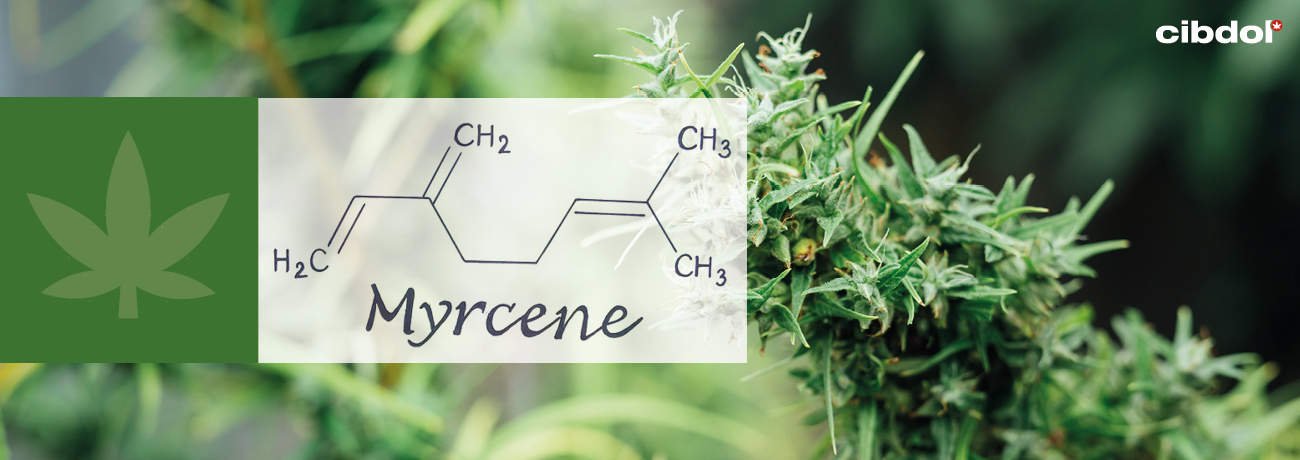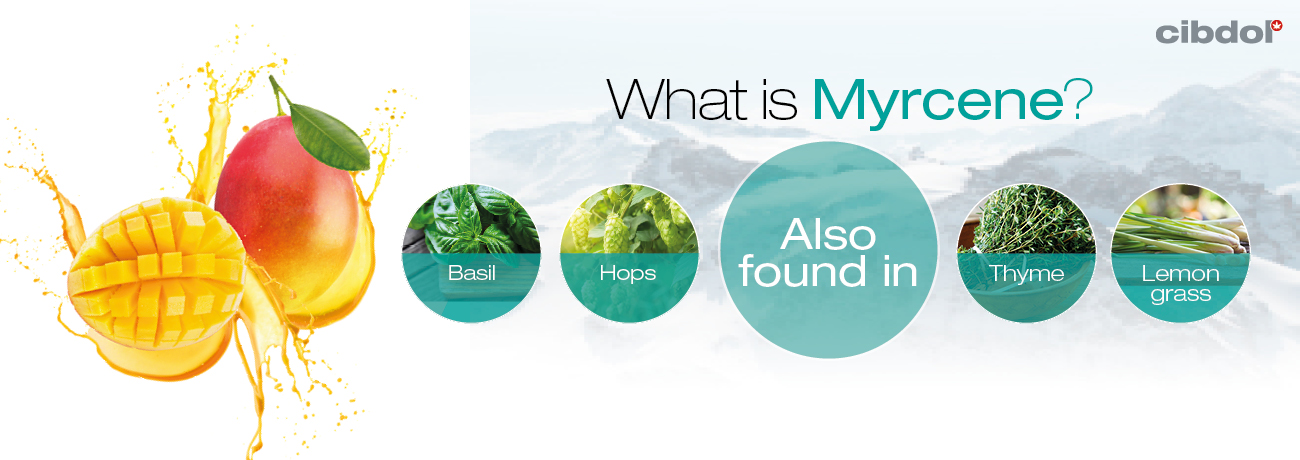What is Myrcene?

Myrcene is the most abundant terpene found in Western cannabis chemovars.
That’s quite the achievement, considering the plant produces over 200 different terpenes. Myrcene provides pleasant aromas, as well as relaxing and somewhat sedating effects. The molecule features two isoprene units, classifying it as a monoterpene.
Cannabinoids have occupied the forefront of cannabis research for quite some time. However, more recently, researchers have turned their attention toward terpenes like myrcene. These molecules are demonstrating intriguing therapeutic potential in preliminary research.
Research suggests that myrcene possesses several medicinal properties, and also appears to synergise with cannabinoids.
Let’s explore the characteristics of myrcene, then delve into what the research says.
Aroma
Myrcene emits an earthy and musky aroma, not dissimilar to that of cloves. These scents contribute to the signature smell of hemp flowers, as well as other culinary and medicinal herbs.
Also found in
Myrcene’s unique aroma and taste underpin the properties of several common herbs and fruits. Mangoes, hops, thyme, basil, and lemongrass all contain high levels of the terpene. Rosemary also contains a significant amount—myrcene makes up around 12.4%[1] of rosemary essential oil.

Possible effects
Researchers have been testing myrcene for its therapeutic effects for decades. Unfortunately, there’s a distinct lack of clinical trials. At this point, it’s not possible to say how exactly myrcene works in humans, or the effect it has.
However, a battery of cell and animal studies provide insight into what future human studies might discover.
Research suggests that myrcene might synergise with certain cannabinoids, amplifying their medicinal effect. This phenomenon has become known as the “entourage effect[2]”. Myrcene appears to enhance the anti-inflammatory effects of CBD, boost the pain-killing properties of THC and CBD, and increase the sedating effects of THC.
So far, myrcene has displayed the following effects in research settings:
• Sedative
• Analgesic
• Anti-inflammatory
• Antioxidant
Supporting research
Countless anecdotal accounts describe the sedating effects of myrcene. Cultivars high in the terpene appear to produce sedating and relaxing properties. Research[3] published in the journal Phytomedicine confirmed that there might be some truth to this.
Researchers administered several terpenes to a group of mice to determine their effects on muscle relaxation and sleep. Myrcene managed to produce muscle-relaxing effects in the rodents at doses of 100 and 200mg/kg of body weight. The terpene also increased the amount of time that mice slept while under the influence of barbiturates—a medication that depresses the central nervous system.
These results indicate that myrcene may have a sedating effect in humans. However, future human trials are needed to confirm these effects. Interestingly, myrcene-rich hops have served as a traditional herbal medicine[4] for insomnia.
Early research has identified the pain-killing potential of myrcene. A study[5] in the Journal of Ethnopharmacology found myrcene to reduce pain in rats following pain-inducing injections. Researchers noted that oral administration of fresh lemongrass reduced pain in a dose-dependent manner.
They proceeded to distil the leaves to obtain the essential oil of the plant. Next, they put the essential oil through silica gel column fractionation and identified myrcene as the main component of the oil. They conducted the test again using only myrcene and identified the terpene as the main pain-killing constituent of lemongrass.
The researchers compared the pain-killing effects of myrcene to morphine. Unlike morphine, myrcene didn’t cause tolerance after repeat injections. The authors of the paper concluded that myrcene should play a role in the development of pain-killing drugs that work through different mechanisms than aspirin-like compounds.
Myrcene has also demonstrated antioxidant effects. Antioxidants are recognised as important molecules that help to protect against DNA damage. They work to neutralise free radicals that would otherwise contribute to ageing and a host of chronic diseases.
Research published in the journal Food Control found chemovars with high levels of myrcene to possess greater free radical scavenging capacity[6].
[1] Porte, A., Godoy, R. L. D. O., Lopes, D., Koketsu, M., Gonçalves, S. L., & Torquilho, H. S. (2000). Essential Oil of Rosmarinus officinalis L. (Rosemary) from Rio de Janeiro, Brazil. Journal of Essential Oil Research, 12(5), 577–580. https://doi.org/10.1080/10412905.2000.9712163 [Source]
[2] Russo, E. B. (2011b). Taming THC: potential cannabis synergy and phytocannabinoid-terpenoid entourage effects. NCBI. Published. https://doi.org/10.1111/j.1476-5381.2011.01238.x [Source]
[3] do Vale, T. G., Furtado, E. C., & Santos, J. G. (2002). Central effects of citral, myrcene and limonene, constituents of essential oil chemotypes from Lippia alba (Mill.) N.E. Brown. ProQuest. https://www.proquest.com/openview/45f6f29733a56f6fb3d43f5647ce2831/1?pq-origsite=gscholar&cbl=32055 [Source]
[4] WebMD. (2021). Alternative Treatments for Insomnia. https://www.webmd.com/sleep-disorders/alternative-treatments-for-insomnia [Source]
[5] Lorenzetti, B. B., Souza, G. E., Sarti, S. J., Santos Filho, D., & Ferreira, S. H. (1991). Myrcene mimics the peripheral analgesic activity of lemongrass tea. Journal of Ethnopharmacology, 34(1), 43–48. https://doi.org/10.1016/0378-8741(91)90187-i [Source]
[6] Ojeda-Sana, A. M., van Baren, C. M., Elechosa, M. A., Juárez, M. A., & Moreno, S. (2013). New insights into antibacterial and antioxidant activities of rosemary essential oils and their main components. Food Control, 31(1), 189–195. https://doi.org/10.1016/j.foodcont.2012.09.022 [Source]
[1] Porte, A., Godoy, R. L. D. O., Lopes, D., Koketsu, M., Gonçalves, S. L., & Torquilho, H. S. (2000). Essential Oil of Rosmarinus officinalis L. (Rosemary) from Rio de Janeiro, Brazil. Journal of Essential Oil Research, 12(5), 577–580. https://doi.org/10.1080/10412905.2000.9712163 [Source]
[2] Russo, E. B. (2011b). Taming THC: potential cannabis synergy and phytocannabinoid-terpenoid entourage effects. NCBI. Published. https://doi.org/10.1111/j.1476-5381.2011.01238.x [Source]
[3] do Vale, T. G., Furtado, E. C., & Santos, J. G. (2002). Central effects of citral, myrcene and limonene, constituents of essential oil chemotypes from Lippia alba (Mill.) N.E. Brown. ProQuest. https://www.proquest.com/openview/45f6f29733a56f6fb3d43f5647ce2831/1?pq-origsite=gscholar&cbl=32055 [Source]
[4] WebMD. (2021). Alternative Treatments for Insomnia. https://www.webmd.com/sleep-disorders/alternative-treatments-for-insomnia [Source]
[5] Lorenzetti, B. B., Souza, G. E., Sarti, S. J., Santos Filho, D., & Ferreira, S. H. (1991). Myrcene mimics the peripheral analgesic activity of lemongrass tea. Journal of Ethnopharmacology, 34(1), 43–48. https://doi.org/10.1016/0378-8741(91)90187-i [Source]
[6] Ojeda-Sana, A. M., van Baren, C. M., Elechosa, M. A., Juárez, M. A., & Moreno, S. (2013). New insights into antibacterial and antioxidant activities of rosemary essential oils and their main components. Food Control, 31(1), 189–195. https://doi.org/10.1016/j.foodcont.2012.09.022 [Source]







